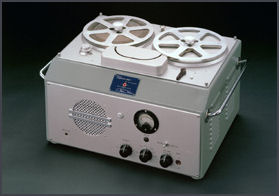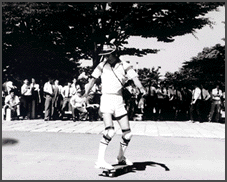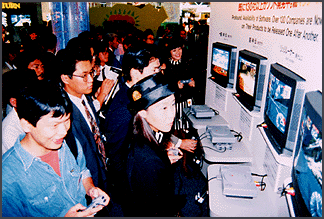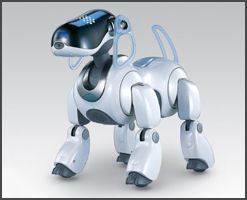SONY PRODUCTS

1950 tape recorder An executive of a rival company summed up Sony strategy as bringing “to market every product they dream up and see what sticks.” Many say companies like Apple have found success by taking Sony technology and taking it a step further.
Sony produces about 100 million devices a year, with a design sense that was the envy of its competitors until Apple recharged. Over the years lucrative products have included flat-screen TVs, robots, cordless phones, computers, laptop computers, video games consoles, boom boxes, surround sound speakers, memory sticks, DV-CD players, camcorders, universal remotes, Walkmans, Discmans and a lots of other stuff. Sony’s reputation allows the company to charge 20 to 30 percent more than its competitors for similar products.
According to the Guinness Book of Records, the world's largest television was a Sony Jumbo Tron color television screen used at the Tsukuba International exposition in 1985 near Tokyo. It measured 80 by 150 feet. Sony produced the world's largest screen at 2005 Aichi Expo. It was 2005 inches wide.
Sony has also produced the world's smallest cassette: the NT digital cassette used in dictating machines. It measures 1/5-by-4/5-by-1/5 of an inch. Sony also makes a waterproof radio powered by a hand crank generator. It is particularly useful in natural disasters and sells for $103.
Sony was less successful in its computer ventures than it would have liked. It introduced 3a .5 inch floppy disc, which became the industry standard but a joint venture with Apple didn't pan out. Only recently has found some success with its ultra-thin Vaio laptops.
Consumer electronics account for more than two thirds of Sony’s sales. The breakdown of earnings by division in 2004 was: 1) electronics ($47.1 billion): 2) games ($7.5 billion); 3) films ($7.3 billion) 4) financial services ($5.7 billion) 5) music ($5.4 billion) 6) Other ($3.2 billion).
The main focus of Sony business today is in gaming, personal computers, Blue-ray disc products, computer chips, LCD televisions, digital cameras and cell phones.
Websites and Resources
Good Websites: Sony.com www.sony.com ; Wikipedia article on Sony Wikipedia ; Sony History sony.net/SonyInfo/CorporateInfo/History ; Akio Morita Library akiomorita.net ; Walkman History pocketcalculatorshow.com ;Sony Aibo Europe sony-europe.com/aibo ; Wikipedia article on Sony Robot Wikipedia ; Sony Computer Science Laboratory www.sonycsl.co.jp ; Book: “Sony: Private Life” by John Nathan, a professor of Japanese Cultural Studies at the University of California, Santa Barbara (Houghton Mifflin, 1999). It is a very good book.
Sony Video and Computer Games Sony Computer Entertainment www.scei.co.jp ;Japan Video Games japanvideogames.com ; Wikipedia article on Sony Computer Entertainment Wikipedia ; Offical PlayStation site us.playstation.com ; Sony’s wii latimesblogs.latimes.com
Sony Walkman

early Walkman promotion The Walkman miniature cassette player first went on sale in July, 1979. Inspired by pocket cassette recorders designed for dictation, it changed the way we lived by making music and electronics portable, personal and mobile. It changed the lifestyles and listening habits of millions and was particularly embraced by young people, commuters and joggers. In 1986, "Walkman" was added to the Oxford English dictionary. For a while it was used as a generic term for all portable music devices.
The Walkman was originally made as a prototype so that Sony co-founder Akio Morita could listen to opera on long-distance flights. The device, which was original marketed in Britain as the Stowaway, almost didn’t happen. “Everybody gave me a hard time,” Morita said in his memoirs. Sony engineers and executive said it was ludicrous to sell a tape-player without a recording function. It took a while for the Walkman to catch on. Sales initially were sluggish.
The Walkman has been described as Morita’s product and his greatest contribution to Sony. It was Ibuka who came up with the idea for product but Morita was the one who overcame resistance of senior Sony executives to bring the product to market.
The Walkman was the right product for the right time. It was the prefect device for the me generation era and the fitness craze. Its headphone output jack was originally named "guy" and input hole "doll." A famous Walkman ad from the 1980s featured a monkey (a Japanese macaque) listening to a Walkman with a very human-like relaxed, content expression on its face.
The Walkman was followed by Watchman mini television (1982) and Discman compact disc player (1984) and hundred of imitations by competitors.
As of 2004, 340 million Walkman had been sold and130 different Walkman models had been released. They included models that ran MDs and memory sticks. The first device to gain as much attention as Sony’s Walkman was Apple Ipod, released in 2004. In response to that Sony introduced a hard disk Vaio pocket and a hard disk Walkman.
In September 2009, after four years of being beat, Sony finally managed to top Apple in the portable music players sector with Sony having a 43 percent share of the market, compared to 42.1 percent for Apple. In October 2010, Sony announced it was cease producing conventional Walkman cassette players. They were done in by competition from MP2 players and Ipods. They lasted for 31 years.
3-D and New Sony Television Technology

Sony plans to release a aline of 3-D ready televisions in 2010 capable of synching with sensing unit and “active shutter glasses” for 3-D viewing. At the Consumer Electronics Show in Las Vegas in 2010, with Taylor Swift performing at the press conference, Sony CEO Howard Stringer said, “We intend to take the lead in 3-D. We want to provide the most compelling 3-D content possible”.
Sony has teamed up with Discovery and IMAX on a 3-D television network and with ESPN to broadcast soccer and golf matches in 3-D. Sony plans to begin selling 3-D LCD televisions and 3-D blue-ray disc players in 2011.
Sony introduced a 70-inch flat television, the largest commercially available at the time, and 14 other new Bravia models in September 2007. The 70-inch model sold for $35,000. Sony also produced the world’s slimmest LCD television. The 40-inch ZX1 series is 9.9 millimeters thick and weighs only 12.2 kilograms. It has a wireless system and doesn’t need a cable and can be hung from a wall The ¥150,000 Bravia KDL-32JE1 is a “green” LCD television which consumers 82 watts of energy while operating compared to the normal 125 watts.
Sony began selling the world’s first televisions using organic light-emitting diode technology (OLED) in December 2007, with the release of an 11-inch model that is only three-millimeters thick and sells for about $2000. The technology — which features panels made of a material that lights up when electricity is passed through it — can be use to make slimmer television as OLED displays because do not have to be backlit as is the case with liquid crystal displays. Sony launched OLED research in 1994. In February 2008, Sony said it would invest ¥22 billion developing larger OLED panels.
Sony is starting to sell organic electroluminescense (EL) televisions, with a display as thin as three millimeters, in the United States. These machines does not need to be backlit and continue to show images even when bent. Sony hopes to use them to make electronic paper. In January 2007, unveiled a new ultra-thin EL television that was less than 1 centimeter thick at its thinnest point.
In the autumn of 2008, Sony began delivering feature films and television shows directly to Bravia television sets without using satellite or cable distributors, but through the Internet, an industry first.
In September 2011, Sony unveiled the world's first 4K home theater projector -- the same standard currently used in full-size cinemas — that displays images foour times finer than high-definition resolution. The company plans to start shipping it in December via their network of custom installers. The VW1000ES will offer 2,000 ANSI-lumens of brightness, a million to one dynamic contrast ratio and support for both 2D and 3D anamorphic films. By the way, the binary term 4K refers to the 4,096 pixels in each of its 2,160 rows. According to our calculators, that makes 4K's resolution about 4 1/4 times that of (1920 by 1080) HDTV, suitable for towering 2-story home theater screens. [Source: Discover News]
Sony’s Online Products
Hiroko Tabuchi wrote in the New York Times, “In early 2010 Sony introduced a new online service that will eventually let users download music, television shows, movies and games from the company’s extensive library onto gadgets like computers, Blu-ray players, televisions, game consoles and digital cameras. The network, tentatively called the Sony Online Service, will be based on the company’s existing PlayStation Network, a game download site with more than 40 million accounts. [Source: Hiroko Tabuchi, New York Times, March 28, 2010]
Sony has launched cloud-based music and movie streaming services with the hope of overtaking Apple as the leader in the field. In the spring of 2010, Sony started a video distribution service in the United States. In the fall it started Qriocity, a video and music streaming service, in Europe.
“Sony tried to marry its hardware with content” before, Tabuchi wrote. In 1987, Sony bought CBS Records for $2 billion and followed through two years later with a $3.4 billion purchase of Columbia Pictures. By the late 1990s, Sony was pushing what it called a “ubiquitous value network,” in which gadgets would seamlessly communicate with one another, beaming back and forth music, movies, messages and phone conversations.” But the idea didn’t really catch on back then.
Sony PlayStation

checking out Play Station in 1994 Sony was a late arrival in the video game business. The company brass regarded Sony as strictly an audiovisual company and regarded entrance into the "game and toy" market as embarrassing.
The success of Sony’s game consoles have been credited to Ken Kutaragi, a former engineer and the CEO of Sony Computer Entertainment and the “the father of the Playstation.” He was the one that convinced Sony to go into gaming alone after a deal with Nintendo fell through. He assembled a team that developed PlayStation from scratch in the 1990s. His team outdid itself with PlayStation II, which was made with components made from scratch (in the past consoles were made with off the shelf parts).
PlayStation and its sequel Playstation2 were invented by a team led by Kutaragi. Sony's success was based in part on the wooing of independent games designers, who were tired of being manipulated by Nintendo. PlayStation sold well and games played on it sold well.
Sony PlayStation was launched in 1994. It was introduced to compete with Nintendo’s Super Famicon, which had debuted only weeks before. The irony is that Sony developed the game console after Nintendo pulled out of a joint venture.
In 1998 PlayStation1 earned Sony $5 billion and 40 percent of its profits. By 2000 one in every four U.S. households had one. The 100 millionth PlayStation was shipped in May 2004. Of these about 70 million were PlayStation2s But by that time sales had slowed to a point that Sony’s net income was hurt.
See Separate Article SONY VIDEO GAMES, PLAYSTATION AND PORTABLE DEVISES factsanddetails.com
Sony Music
Sony Music is Japan’s largest record company. In the late 1980s Sony purchased Columbia Records Group for $2 billion. Like Columbia Pictures, its record was also spotty, and has included disputes with big stars like Bruce Springsteen, George Michael and Michael Jackson.
In 2002, Michael Jackson had a widely publicized legal battle with Sony. With Johnnie Cochran and the Rev. Al Sharpton acting as advisors, he called Sony music racist and called the head of Sony music the devil, drawing a picture of him with horns and a pitchfork, and blamed the company for not promoting his new album. The move was widely seen as an attempt by Jackson to win concessions from Sony, which co-owns Jackson’s valuable music catalogue, which includes his hit songs as well as many songs by the Beatles.
In the late 1990s, Sony tried to jazz up its image. A 1997 Sony Music Entertainment ad in a British rock magazine went: "Three essentials for a great holiday. Sex, drugs, and rock and roll. We'll provide the rock and roll. You take care of the rest."
In 2004, Sony and BMG (Bertelsmann) merged to create the world’s second largest music company after Vivendi Universal Music.The new company was called Sony-BMG. The new company had $4.5 billion to $5 billion in annual sales and embraces artists like Aerosmith, Beyonce and Britney Spears.
In August 2008,Sony agreed to buy Bertelsmann’s entire 50 percent stake in Sony BMG music for $900 million and took full control in October 2008. The decision ended the four-year Sony-Bertelsmann music partnership that was characterized by the New York Times as “more dissonance than harmony.”
Share of U.S. music album sales: 1) Vivendi Universal Music (32 percent); 2) Sony and BMG (25 percent, with Sony 15 percent and BMG 10 percent); 3) Warner Brothers (21 percent); 4) EMI Music (9 percent); and Independents (14 percent).
Sony Artists include Jennifer Lopez, the Dixie Chicks, The Offspring. BMG artists include Avril Lavigne, OutKast, Usher, Foo Fighters, Elvis Presley, Miles Davis, Johnny Cash and Stevie Ray Vaughan.
Sony Smart Grid
In October 2011, Sony announced it has joined the “Pecan Street Smart Grid Demonstration Project” in the United States. As a participating company in this smart grid demonstration experiment built around home applications and consumer electronics, Sony is evaluating and developing Home Energy Management Systems (HEMS) that enable continual use of energy for practical and experimental uses. [Source: Sony]
Smart grid approach involves connecting smart meters (next-generation electricity meters), such as those installed in households, to a network. This provides a real time picture of electricity demand, thus optimizing the supply and usage of electricity. The main objectives of this approach are to make the production and supply of electricity more efficient. In an aim to create end-user benefits, Sony decided to participate in the Pecan Street Smart Grid Demonstration Project, which places a strong emphasis on producing benefits to end-users.
Sony Electric Car Batteries
Sony Corp. is in talks with several automakers inside and outside of Japan to make lithium-ion batteries for electric vehicles from the middle of the 2010s, a company executive said. “We will consider building factories, including one overseas, if demand becomes full blown,” Sony Senior Vice President Shigeki Ishizuka told reporters at a new factory for building battery devices in Motomiya, Fukushima Prefecture. The company will also consider developing batteries for gasoline-electric vehicles and plug-in hybrids, Ishizuka said. [Source: Kyodo, July 13, 2011]
The Japanese electronics maker is currently developing a lithium-ion battery with a long life that is resistant to deterioration even when recharged repeatedly. Sony has developed 1.2 kWh energy storage modules using rechargeable Li-ion batteries with olivine-type lithium-ion iron phosphate as the cathode material. (Earlier post.) Used in conjunction with a control device, the module can be as a backup power supply for data servers or cell phone reception towers. Alternatively it can be an energy storage system for residential use.
In addition, the module can be incorporated into recharging stations for electric vehicles as the technology for the built-in rechargeable olivine-type lithium-ion iron phosphate cells facilitates rapid recharging and high power output.
Sony Human Robots

In the early 2000s Sony introduced the 50-centimeter-tall, 5-kilogram SDR-3X. Looking like like a mechanical spacemen and built from many of the same parts as Asimo, it could dance, kick soccer balls, speaks a few word, pick the right color, and do the splits. SDR stands for Sony Dream Robot.
SDR-4X was 60 centimeters tall and could recognize faces and voices and sing in perfect harmony with SDR-4Xs. If it fell down it could pick itself up. Equipped with two cameras and seven microphones so it could see and hear better, it could dodge obstacles, remember people’s names, use 60,000 words and can carry on limited conversations.
In demonstrations, SDR-4Xs danced in unison, sang a four-part harmony and balanced themselves on tilting surfboards. SDR-4X II had an expanded vocabulary and musical repertoire Sony gave up marketing SDR is 2002 because the price of owning one would be equivalent to an expensive imported car.
The QRIO robot, which looked like SDR-4X, was unveiled in December 2003. It could “run” at speeds of 0.84 kilometers per hour, jump, move sideways, make circling movements, roller skate, dribble a ball and get up by themselves when they fell down. Although difficult to detect with the naked eye, the robot’s two feet come of the ground for .02 second when it runs and .04 second when it jumps.
The version of QRIO that came out in late 2005 It could also walk heel to toe as humans do, negotiate obstacles, disco dance, balance on one leg, do tai chair movements, conduct Beethoven’s 5th Symphony and find a golf ball and putt thanks to an improved ability to recognize three similar objects. It could also pick up a block and place it on a target on the floor, using a third eye — a camera with 180-degree view — to determine the shape and right spot. Its rental fee was around $200,000.
Sony pulled the plug on the QRIO robots and Aibo in 2006 as parts of its move to streamline the company and shed unprofitable divisions.
Aibo

Aibo, a robotic dog with hound dog ears, was introduced by Sony in June 1999. Created by Sony engineer Toshi Doi, it is about the size of a medium-size terrier and it has 18 electric motors in its joints, a camera in its nose and a micro chip in each detachable leg. It took five years to develop. Aibo is the Japanese word for "buddy." It also stands for Artificial Intelligence Robot.
After pushing Aibo's start up button a speaker in the mouth chest produces an electronic chime. Aibo comes to life after about two minutes of uploading digital data. Once activated Aibo wags its tail, sits, heels, raises and licks its paw, and spins its limbs completely around. It can climb on its feet when its on it back and chases a ball but can not pick it up.
Aibo has absolutely no practical applications. He moves around without the orders of it owner and has a mind of its own. Its eyes go red if you pay him too hard. If you takes his ball away he gives you a dirty look. Aibo look and acts so much like a dog even real dogs are captivated by its presence.
Even though Aibo sold for $2,500, all 3,000 units sold out in Japan within 20 minutes after Sony began accepting orders for it after its introduction. In November 1999, Sony announced it had received 130,000 orders for 20,000 additional Aibos. In the United States, Sony's Internet server crashed as millions tried to get their hands on the 2,000 Aibos allocated for the United States.
By 2006, about 150,000 Aibos had been sold, 90 percent of them in Japan. By then it was selling for about $700.Aibo spawned numerous websites and fan clubs and even a magazine called Aibo Town. He was featured in a Janet Jackson video and a National Geographic article. One woman in Tokyo treated her two Aibos like real dogs. She prepared meals for them and rapped them in scarves when it was cold. Another couple bought an Aibo after their daughter moved out of the house.
Website: www.aibo.com
Aibo II
Aibo II, officially known as ERS-210, was smarter, cheaper and more interactive than its predecessor. Modeled after a lion cub, it recognized voice commands, responded to his name, wiggled his ears, learned from experience, took photographs with the camera in its head, danced a little jig, had increased brain power and greater "free will," and could express joy, sorrow, anger, surprise, fear and dislike. Released in Japan in November 2000, he sold for less than $1,000 but required about $500 worth of extra software, battery chargers and gadgets to get the most out of him.
Aibo II waved it paw when it heard its name. Its voice-recognition software allowed it to learn up to 50 commands such as "Give me your paw." While the first Aibo was regarded as a stand-alone machine, Aibo II was regarded as a entire platform for robotics. It contained a 64-bit microprocessor and 32 bytes of memory. An editor of Aibo Town called the two robots as different as a word processor and computer.
One Aibo owner told the Daily Yomiuri, "When I communicate with my Aibo, its kind of a mirror of my own emotions. I project my emotions onto Aibo, and the reflection comes back to me. So to communicate with robots is really to communicate with ourselves." An owner of 40 Aibos said, “I love them, they’re great. I think of them as dogs.”
Last Aibo Models

advanced Aibo The forth generation Aibo, ERS-220, boasted new hardware that enabled it to communicate and respond more expressively. Selling for $1,500, plus $250 for additional software and card, it looked more robotic and displayed its emotions with more lifelike movements and had 19 lights that flashed red or blue.
In October 2001, Sony began marketing Aibo LM, a cuter, less robotic-looking version of Aibo that came in two varieties: a white robot named Latter and a gray one called Macaron. They sold for $850 each and were put on the market around the same time a cartoon about them began appearing on television.
The new Aibo ERS-7, released in 2003, had “eyes” and was programed to act like a watch dog. Using Bluetooth wireless technology, it could transmit messages such as “I’m tired” and “Play with me.” This Aibo had better image-recognition functions and an improved body mechanism for more fluid motions, It had 28 multicolored light emitting diodes on its face to mimic emotions and a speaker to replay sounds. Owners could download software off the Internet. It sold for $1,700.
The last Aibo could “learn” by becoming more adept at certain actions over time. It could speak and understand 1000 words, including some in Spanish. A camera in its could relay images to a laptop so laptop users could have the dogs point of view.
Sony ended production of Aibo in 2006 as parts of its move to streamline the company and shed unprofitable divisions. The plug was also pulled on the Qrio robots.
Other robot dogs out there include Lil Scratch from Trendmaster ($60 a pair), iCybie from Tiger Electronics ($130), Poo-Chi from Tiger Electronics ($28), Robotic Puppy from Fisher-Price ($100), Me and My Shadow from MGA ($60) and Tekno from Manley Toy Quest ($30)
Image Sources: Sony except PlayStation 4 protoypes ( Sony Guru blog)
Text Sources: New York Times, Washington Post, Los Angeles Times, Daily Yomiuri, Times of London, Japan National Tourist Organization (JNTO), National Geographic, The New Yorker, Time, Newsweek, Reuters, AP, Lonely Planet Guides, Compton’s Encyclopedia and various books and other publications.
Last updated October 2011
